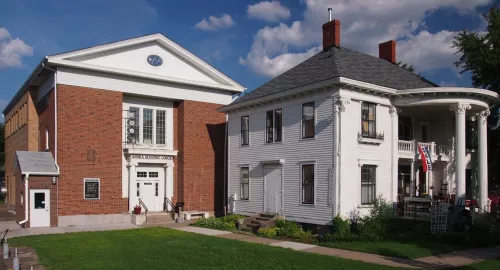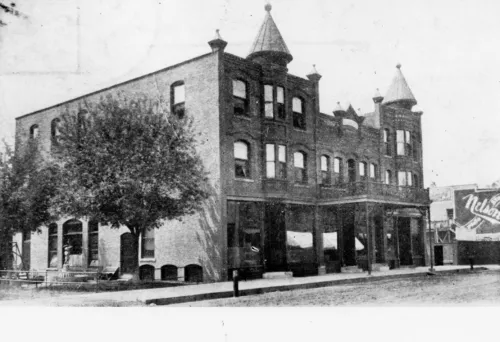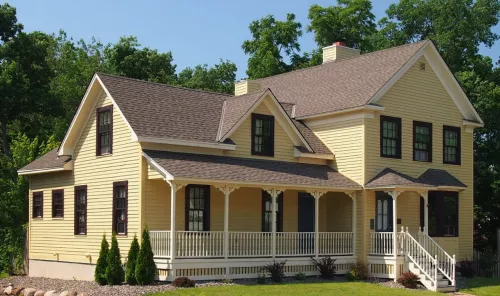Share what you know,
and discover more.
Share what you know,
and discover more.
Dec 27, 1979

-

- Charmaine Bantugan
National Register of Historic Places - Heman L. Ticknor House (Mattson House)
Statement of Significance: The Ticknor House is historically significant due to its association with three generations of a family that contributed to the historic development of Anoka from 1855 throughout the 1920s. Additionally, the design of the house incorporates well-preserved design features of the Gothic Revival style (evident in the 1867 design of the original house), and the Queen Anne and Neo-Classic styles (evident in the 1901 "remodeling"). The design of the house represents an interesting evolution of three generations of the Ticknor family's architectural tastes. The builder of the house, Heman L. Ticknor, was a native of Massachusetts who moved to Anoka in 1855, one year after the town was surveyed and platted. In that year, Ticknor opened the first dry goods and grocery store on the east side of the Rum River. Ticknor was the first merchant to note the strong settlement trends to the north and east of the river. He operated this store until 1860, at which time he began the manufacture of cigars. From 1864 until his death in 1897, Ticknor operated Anoka's first drugstore. In addition to these commercial interests, Ticknor owned several brick blocks, stores, and dwellings in Anoka. He served as a county commissioner in 1864. For several years, Ticknor served as president of the First National Bank of Anoka, and as director and treasurer of the Anoka Boot and Shoe Factory. After Ticknor's death, his daughter and son-in-law, Zale and John H. Niles, inherited the house. Zale was instrumental in establishing the Anoka Library. John H. Niles, a native of New York, was, for many years, a prominent lawyer in Anoka who specialized in abstract law. It was during the Niles' ownership that the house was extensively remodeled. In 1930 the house was further remodeled by the third generation of Ticknor's to own the house. Architecturally, the Ticknor House represents an interesting juxtaposition of three historic architectural styles. The original design of the house, best defined as Gothic Revival, was popularized by Andrew Jackson Downing through his widely distributed book. The Architecture of Country Houses. The Gothic Revival design that remains intact from 1867 includes the overall verticality of the house, its conspicuous gables with elaborately decorated bargeboards, ‘and the Gothic arched windows in the projecting gable on the front facade. The 1901 "remodeling" of the house involved an elaborate plan that included the division of the house into three sections, with the front and back sections switched, leaving the middle section unchanged. This resulted in a new orientation of the house — prior to this, the house overlooked the Rum River. After the interchange of sections, the house faced Third Avenue South, the fashionable street to live on in Anoka at the turn of the century. Further remodeling in 1901 involved the addition to Queen and Neo-Classic architectural features. The current owners of the house have recently completed extensive restoration of both the interior and exterior of the house.
National Register of Historic Places - Heman L. Ticknor House (Mattson House)
Statement of Significance: The Ticknor House is historically significant due to its association with three generations of a family that contributed to the historic development of Anoka from 1855 throughout the 1920s. Additionally, the design of the house incorporates well-preserved design features of the Gothic Revival style (evident in the 1867 design of the original house), and the Queen Anne and Neo-Classic styles (evident in the 1901 "remodeling"). The design of the house represents an interesting evolution of three generations of the Ticknor family's architectural tastes. The builder of the house, Heman L. Ticknor, was a native of Massachusetts who moved to Anoka in 1855, one year after the town was surveyed and platted. In that year, Ticknor opened the first dry goods and grocery store on the east side of the Rum River. Ticknor was the first merchant to note the strong settlement trends to the north and east of the river. He operated this store until 1860, at which time he began the manufacture of cigars. From 1864 until his death in 1897, Ticknor operated Anoka's first drugstore. In addition to these commercial interests, Ticknor owned several brick blocks, stores, and dwellings in Anoka. He served as a county commissioner in 1864. For several years, Ticknor served as president of the First National Bank of Anoka, and as director and treasurer of the Anoka Boot and Shoe Factory. After Ticknor's death, his daughter and son-in-law, Zale and John H. Niles, inherited the house. Zale was instrumental in establishing the Anoka Library. John H. Niles, a native of New York, was, for many years, a prominent lawyer in Anoka who specialized in abstract law. It was during the Niles' ownership that the house was extensively remodeled. In 1930 the house was further remodeled by the third generation of Ticknor's to own the house. Architecturally, the Ticknor House represents an interesting juxtaposition of three historic architectural styles. The original design of the house, best defined as Gothic Revival, was popularized by Andrew Jackson Downing through his widely distributed book. The Architecture of Country Houses. The Gothic Revival design that remains intact from 1867 includes the overall verticality of the house, its conspicuous gables with elaborately decorated bargeboards, ‘and the Gothic arched windows in the projecting gable on the front facade. The 1901 "remodeling" of the house involved an elaborate plan that included the division of the house into three sections, with the front and back sections switched, leaving the middle section unchanged. This resulted in a new orientation of the house — prior to this, the house overlooked the Rum River. After the interchange of sections, the house faced Third Avenue South, the fashionable street to live on in Anoka at the turn of the century. Further remodeling in 1901 involved the addition to Queen and Neo-Classic architectural features. The current owners of the house have recently completed extensive restoration of both the interior and exterior of the house.
Dec 27, 1979
National Register of Historic Places - Heman L. Ticknor House (Mattson House)
Statement of Significance:The Ticknor House is historically significant due to its association with three generations of a family that contributed to the historic development of Anoka from 1855 throughout the 1920s. Additionally, the design of the house incorporates well-preserved design features of the Gothic Revival style (evident in the 1867 design of the original house), and the Queen Anne and Neo-Classic styles (evident in the 1901 "remodeling"). The design of the house represents an interesting evolution of three generations of the Ticknor family's architectural tastes.
The builder of the house, Heman L. Ticknor, was a native of Massachusetts who moved to Anoka in 1855, one year after the town was surveyed and platted. In that year, Ticknor opened the first dry goods and grocery store on the east side of the Rum River. Ticknor was the first merchant to note the strong settlement trends to the north and east of the river. He operated this store until 1860, at which time he began the manufacture of cigars.
From 1864 until his death in 1897, Ticknor operated Anoka's first drugstore. In addition to these commercial interests, Ticknor owned several brick blocks, stores, and dwellings in Anoka. He served as a county commissioner in 1864. For several years, Ticknor served as president of the First National Bank of Anoka, and as director and treasurer of the Anoka Boot and Shoe Factory.
After Ticknor's death, his daughter and son-in-law, Zale and John H. Niles, inherited the house. Zale was instrumental in establishing the Anoka Library. John H. Niles, a native of New York, was, for many years, a prominent lawyer in Anoka who specialized in abstract law. It was during the Niles' ownership that the house was extensively remodeled. In 1930 the house was further remodeled by the third generation of Ticknor's to own the house.
Architecturally, the Ticknor House represents an interesting juxtaposition of three historic architectural styles. The original design of the house, best defined as Gothic Revival, was popularized by Andrew Jackson Downing through his widely distributed book. The Architecture of Country Houses. The Gothic Revival design that remains intact from 1867 includes the overall verticality of the house, its conspicuous gables with elaborately decorated bargeboards, ‘and the Gothic arched windows in the projecting gable on the front facade. The 1901 "remodeling" of the house involved an elaborate plan that included the division of the house into three sections, with the front and back sections switched, leaving the middle section unchanged. This resulted in a new orientation of the house — prior to this, the house overlooked the Rum River. After the interchange of sections, the house faced Third Avenue South, the fashionable street to live on in Anoka at the turn of the century. Further remodeling in 1901 involved the addition to Queen and Neo-Classic architectural features.
The current owners of the house have recently completed extensive restoration of both the interior and exterior of the house.
Posted Date
Jul 25, 2022
Historical Record Date
Dec 27, 1979
Source Name
National Register of Historic Places
Source Website
Delete Story
Are you sure you want to delete this story?














